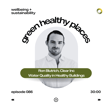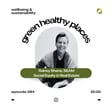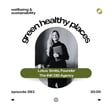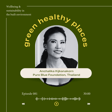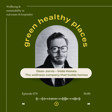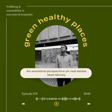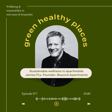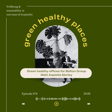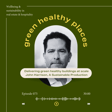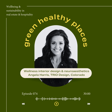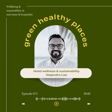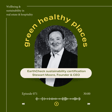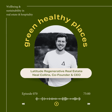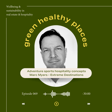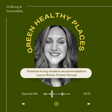Introduction to Episode 65
00:00:12
Speaker
Welcome to episode 65 of the Green Healthy Places podcast, in which we discuss the themes of wellbeing and sustainability in real estate and hospitality today. This
Innovative Approach to Public Restrooms
00:00:24
Speaker
week, we're in the Netherlands talking to Marielle Romain, co-founder of 100 Restrooms, an innovative brand disrupting the public toilet market by focusing on environmental consciousness and wellness benefits.
Design and Market Disruption
00:00:39
Speaker
design modules can be found across shopping malls, railway stations, and roadside service stations in Spain, Belgium, and Sweden, as well as their home country.
Features and Sustainable Goals
00:00:49
Speaker
We discuss the birth of the brand, their business model, how modular design allows them to customize each experience according to each site, the integration of Internet of Things, IoT technology, into that experience, how they align with UN sustainable development goals,
00:01:06
Speaker
the use of multi-sensory design features to upgrade the toilet break experience and their relentless pursuit of ever higher hygiene standards. For me, Mariel's company is an example of how concepts from green building and healthy building design are now filtering down through the value train.
00:01:26
Speaker
Do have a look at the visuals of the restrooms online. They really are a breath of fresh air. So let's do this. Here is Marielle Romain of 100 Restrooms. Great.
Origins and Inspirations
00:01:42
Speaker
Well, Marielle, thank you for joining us on the show. It's lovely to have you here. Yeah, thanks for inviting me. Really nice to share our story.
00:01:50
Speaker
This is a little bit different. You know, we're often talking about buildings or we're talking about hotels. You've taken a slice, a particular piece of a building or a shopping mall or a service station. And for me, I completely reinvented it. I was saying before we started recording, I went down to experience a restroom, a 100 restroom.
00:02:12
Speaker
yesterday evening myself and just blown away by the level of detail and thought that's gone into it. So I want to allow you some space to share that story. So why don't we start with how the business was born and where it came from. When you were
00:02:26
Speaker
looking for inspiration for this. What were the sources of, or the trends or the movements in the market that led you and your co-founders to say, you know what, I think there's a market for this, there's an opportunity here. What was
Quality Gaps in Public Restrooms
00:02:41
Speaker
the business case when you started? So I have to be honest, we have a history in public restrooms.
00:02:49
Speaker
We used to work for a company called Toodaloo and this company was actually one of the first brands in public restrooms. And what they discovered is that if you look at it, it's a bit strange that all the core needs that we have like sleeping, eating,
00:03:08
Speaker
going to a toilet. Most of them are, we have a lot of choice in, like we can choose hotels, we can choose restaurants, but we don't have a good choice in public restrooms. Most of
Trends and Inception of 100 Restrooms
00:03:19
Speaker
the times it's scary, it's unsafe, it's not clean and it's far from relaxing. So they already discovered that niche in the market and they said okay this is an opportunity to change
00:03:33
Speaker
and then they came with a concept which was comfortable and clean and it was more into fun and when we worked there with a couple of our co-founders and we found there was more to this. We slightly discovered that of course there were trends where we saw that people were more involved into their own well-being, we saw some technology trends where we saw that
00:03:58
Speaker
restrooms and bathrooms in general becoming more smart and can do also health analysis. So there were a couple of things that we thought were interesting to see how we could integrate them in a restroom concept. And then we decided to start it over, to start it ourselves with a new concept.
Transforming Public Restrooms into Wellness Spaces
00:04:21
Speaker
on the same need and the need is simply to have good public restrooms but with a different vision, a different vision about how to fulfill this need and we really wanted to create a new standard, that's how we call it, a new standard in public restrooms and this standard we believe is something that moves the toilet visit from a moment of stress and anxiety sometimes even
00:04:45
Speaker
to a moment of well-being. And of course, there's a lot in between because you can also offer just simply good and clean toilets, but we thought let's move it ahead to the future and make it a moment of well-being and make it like a five minute boost, we call it.
Retail-like Design and Additional Services
00:05:02
Speaker
so much there. When I went down to visit, I saw biophilic design, I saw elements of wellness interiors where you're creating a multisensory experience. I saw parallels with what's happening in the healthy building movement. So could you perhaps
00:05:20
Speaker
paint that picture. For someone going in and experiencing it for the first time, what are they seeing? What are they hearing on the sound system? What are the services that you're offering? Because I know there's like a core product and then perhaps some extras that are available as add-ons, like a modular design approach, right? Yeah,
Enhancing Experience with Zones
00:05:39
Speaker
absolutely. So when you see the restrooms, it looks like a retail store, I could say. It even has a storefront.
00:05:47
Speaker
And from the outside, sometimes you don't even see the toilets yet. We have a zone that we call the reload zone, and that is where you enter. And the reload zone is a zone where we offer additional services, like, for instance, a hydration station, a nursery, disabled room, but also a health check, pre-health check. And that's before you enter. And then you enter, we have a turnstile where you pay.
00:06:14
Speaker
for the toilet entrance. And then you come into, as we call it, a transition zone, which is a black area where you really make the transition from the outside, which is most of the times busy because we're on public areas. You go through a black zone and then you enter like a white Zen kind of area, which is the restroom area.
00:06:36
Speaker
And there we work with light, indirect lighting. We work with sounds. We use heads sounds, which are working on a certain frequency that calms you down. We have a certain scent that we, based on nature kind of sense, mix together to a specific 100 scent. So it all, I think the combination of sensory experiences makes you feel calm quite soon.
00:07:06
Speaker
Then we have our toilet cubicles, they are fully private so we don't have like open, how do you call it, open doors. So you have your private moment, you have the sounds, it's of course clean, it feels safe.
00:07:24
Speaker
All the elements work towards a moment of well-being. Everything inside is the materialization. We use HPL as our core material. HPL is a very clean material. It's easy to clean, but also when something happens.
00:07:44
Speaker
when people try to put gravity on it or whatever it's we can take it away and I think that's also maybe I'm jumping from subjects now but that's also very important thing is that not only cleanliness but also repair and maintenance and keeping it as new is a very important factor in the sense sensing yeah a good experience or
00:08:07
Speaker
getting the same feeling. In terms of how
Comprehensive Service Package
00:08:10
Speaker
the business model is structured, I know you provide obviously the design piece and the construction as in you're delivering the product and installing the product for whoever your client might be, but then it doesn't end there because you also have a role in terms of the operations and ongoing maintenance. Is that something that
00:08:29
Speaker
is part of one big package is it something that the owner of the client can decide to do themselves or it's you maintain control of the experience on an ongoing basis from the right from the initial design through to whenever the contract ends.
00:08:45
Speaker
Yeah, this is really our concept because it's our brand and we want to keep the standards really high. So it's a full package. We build, like you said, we design, we build, but we also operate and maintain the whole concept during 10 years, meaning we have our own team, our own mechanics. We have field coaches who do audits every week to check if everything is still okay.
00:09:11
Speaker
We have our own staff. We call it a comfort crew. They clean, but they also welcome the guests and explain certain services. So the full concept, including IoT to monitor from a distance, is what makes it a success, I think. I mean, sometimes it's not the hardest part to make a good design, but it's more challenging, especially in a restroom area where you can sometimes have vandalism or other kinds of stuff, to keep it as new.
00:09:41
Speaker
is the most challenging part and that's why we put a lot of effort in as well.
Targeting High-Traffic Areas
00:09:46
Speaker
So you're effectively owning and operating, they are your bathrooms even. So in the context of Spain where I am, I know you have a gentleman who's representing you here in the Spanish market, so his role then would be to look for opportunities and where are you typically finding the best opportunities
00:10:04
Speaker
I know in some countries, in some territories, you've gone more for the motorway service station, upgraded restroom, perhaps here it's more train stations. Is that just where the opportunities are or do you see certain markets are more favorable if it's shopping malls in Sweden or service stations in Netherlands? How's that work?
00:10:24
Speaker
No, that's good question. But in general, we are focused on high traffic areas. And these could be shopping malls, train stations, like highway service stations and sometimes food markets.
00:10:39
Speaker
And of course, it depends a little bit on the market. If they have like big shopping malls with lots of visitors, or if it's small shopping malls, then it's not interesting enough for us from a business case perspective. So depending on the market and also depending on the market opportunities, because a lot of times we are part of tenders. So sometimes we just, of course, there's always
00:11:03
Speaker
an opportunity for a restroom is not every year. Most of the real estate companies rebuild the restrooms maybe once every 10 years or something. So it's also a matter of time. But we are always focusing on train stations, railway, highway and shopping malls.
00:11:23
Speaker
in every country in Europe. They're very much kind of transitory spaces, right, where people are passing through, moving from one space to another, and where perhaps, yeah, the typical experience on offer is really, yeah, just something most of us try to avoid. I think that was really what I picked up from just doing the research online.
IoT and International Operations
00:11:43
Speaker
And you mentioned the IoT internet of things. So how do you use
00:11:48
Speaker
that degree of technology to then maintain visibility on the operations on all of your, I don't know how many sites you have now, but as you build 10, 20 multiples into the hundreds eventually, I guess, how is the technology helping you to maintain service standards? Yeah, so we currently have around 40 sites in four countries. And what we have invested in from the start is to really build on a dashboard that we use to monitor all the sites.
00:12:17
Speaker
And we do it by connecting all the hardware. So starting with, of course, the term style where people enter to monitor the number of visitors, et cetera. But also the dispensers are connected. So we can see whenever a dispenser is empty, we have the water flows connected with water flow systems. So we can see when something is flowing or when something stops flowing, then there's also a problem.
00:12:43
Speaker
We connect our rating tool, we connect our interactive mirrors, so all the information together, we also have a connected repair and maintenance system, the field codes visits are reported, so all the data combined gives us a very clear vision on the state of our toilets and of course by combining it by saying like okay
00:13:08
Speaker
We can see that on a Saturday morning, we have a lot of visitors and we can see that the rating was going down a little bit. So maybe we should put more effort into cleaning at that hour. So it gives us a lot of data to work with.
00:13:22
Speaker
Yeah, that sounds amazing. That's exactly what you need, right? That's how you can maintain the service standards that you're looking for. And is that then how you come up with the sort of future proof bathroom concept on one side integrating tech in a way that really we're just not seeing at least here in Western Europe. I don't know what's happening in, I imagine in countries like Japan, they're probably quite advanced, but then take on one side and then the environmental piece and sustainability on the other. So in terms
Sustainability and Well-being Focus
00:13:51
Speaker
integrates into the brand itself. How are you playing to future-proof the business by working also on environmental friendliness?
00:14:03
Speaker
Yeah, we are focusing really on this point now because from the beginning, we choose our partners based on their sustainability goals. So we work with S&T, with Roca, with Diversity, which are all big brands in our sector that work from sustainable goals and sustainable materials. But what we are doing now currently is we have measured our footprint ourselves for the whole concept.
00:14:32
Speaker
like a life cycle analysis to see, OK, what kind of material input do we have? How much is the usage? What kind of materials can we maybe change to make our footprint less? So that is something that we are currently really focusing on. And apart from that, I think the well-being part is one of the factors that we can create a lot of impact with. And of course, it's not sustainability in the terms of climate, but it is in a bigger
00:15:01
Speaker
perspective, it can create a lot of impact and that is something that we think we can make a difference because we are in the public area. And like you said, when people are on the move or on the go, stress levels are even higher, dehydration is a topic and we try to really be there like a small oasis for people to have this moment of well-being.
00:15:25
Speaker
As the name of the podcast suggests, I think the green combined with the healthy is like the path for businesses when they're looking to the future. I think that it's that combination of the two and they're really the same two sides of one coin. And so on the health and wellbeing piece, you mentioned a couple of things. Hygiene clearly is a big factor. I'd like to understand a bit more beyond just particular materials, but also how you deliver that using any kind of
00:15:52
Speaker
the UV cleaning systems or is it just traditional eco cleaning products and then also that idea of using light and sound and scent because these are things that we might imagine in perhaps in a sort of a co-working office but it's not that that often that we find it in in restrooms right so you've really played that that health and well-being angle I think it'll be great to hear a bit more about that.
00:16:16
Speaker
Okay, so to start with the hygiene and the cleaning, of course, that is the basics and that is the foundation of our success. We have cleaning procedures that we follow all the time. And the cleaning procedures, the ultimate cleaning is to clean after every use, because then people feel like welcome and like the restroom is cleaned for them. This is not always feasible, but what we try to do is to clean all the time.
00:16:44
Speaker
And apart from cleaning all the time, we also have specific deep cleaning schedules that we do every morning or every week or every day. So everything is worked out in processes. And we work with ACO materials, like you said, but apart from that, we are also always in every area. We are trying out new things. And one of the things that we are currently testing, like you already mentioned, is a nano-photolistic coating.
00:17:13
Speaker
that you can spray on surfaces that are most vulnerable for for hygienic topics like for instance toilet seat and it helps to
Testing New Hygiene Technologies
00:17:27
Speaker
prevent viruses and bacteria from sticking to the surface and that of course makes cleaning a bit easier so that's
00:17:37
Speaker
that's technologies that we try out. We are also piloting a system now which is called ozone cleaning. It is actually water with some ozone. I don't even know exactly what the technology entails but we are testing it and it seems to work very well and of course it's more sustainable even than the ACLE cleaning.
00:17:58
Speaker
All kinds of innovative systems are coming to us. We get approached a lot and we tend to also be very open to try out these new things.
00:18:11
Speaker
Um, the, uh, the ozone cleaning, I think was, um, it's had a lot of success in the field of dentistry. And so like dentist, uh, clinics, I know they've been using that for a little while, even before the COVID crisis and then even more. So during that, I was hoping you'd have a few interesting suggestions around hygiene, because, you know, when you're talking to say, you know, it's like, okay, healthy building advisory services for a big.
00:18:35
Speaker
you know, a 30-storey, I don't know, residential or office tower, right? And a lot of it actually is delivered by the facilities management company. And so they'll say, look, Matt, you know, give us the guidelines. And then they'll adjust their own principles, their own operating procedures accordingly. And there's often not that much space to really introduce innovative new technologies. But at least they have
00:18:57
Speaker
a facilities management company who takes responsibility for it and then you can you can work with them in smaller projects you know and i'm working say a gym and you're designing or a health and fitness center hygiene is especially important there as well because you've got a lot of people who are exercising sweating not necessarily thinking about
00:19:18
Speaker
how they leave a machine afterwards. And so there's so many other areas where I think the principles that you're applying, obviously, it's an extreme case. But I think we can take lessons from what you're doing and also what you're not doing, because I assume you've tested a lot of things and realized, well, that didn't work. So let's focus on what does work. And I think that can help guide people who have other spaces that obviously necessarily aren't restrooms, but where you also have issues around hygiene. I think you've gone quite deep into that space.
00:19:48
Speaker
Yeah, yeah, sure. Yeah, absolutely. And I think in the end, it's all a matter of routines and consistency as well. Just make sure that you do it every day or every morning or every week. Because we also have more challenging situations where we see that when you check it, because we check it every week, you see that some corners are getting a little bit dirty or something is not like we want it.
00:20:14
Speaker
And then you need to find a new procedure. If you let that go, if you let it happen, then you see that the concept is losing the newness, or I don't know exactly how to say it, but you need to be focused on every single detail. And we find new things every day. Sometimes we see like, ah, there is a little chalk on the faucet. What can we do? How can we solve that?
00:20:40
Speaker
We buy a new brush and we try to solve it so it's a lot about routines and details and discipline i think as well apart from the materials that are new in the market.
00:20:51
Speaker
And then there are a number of, say, optional extras that seem to go a little bit beyond the basics. You know, I noticed the motivational mirror was kind of giving me various sort of tips beyond the weather and the time and a few other bits of information. It was suggesting, I think, how long to wash my hands for and
00:21:11
Speaker
You know, those pieces and the idea of perhaps a beauty bar or somewhere, I guess for ladies to do their makeup and beyond to hydrate. Is it a way in a sense to play to slightly different target markets? Who's typically going for the optional extras versus to see perhaps service stations keeping it quite simple or just sticking to the core product and then perhaps
00:21:34
Speaker
a luxury shopping mall, for example, I imagine might want a few extras that are less functional and more aesthetic based. Would that be true? Yeah, that's true. And it has a lot to do with the square meters that we have available on the one hand, and on the other hand, the visitor profile and how much time that they have to spend and what is also a need that they have during their shopping visits or a petrol visit, it depends a little bit.
00:22:02
Speaker
But in general, it starts with the square meters. The basic idea is that we always have something, of course, we have something to relieve because that's the restrooms. Refresh is the wash basins and the beauty bars and then reload is the third part and prevent sometimes that we add. Our goal is to always have the three pillars inside every room, whether it's 25 square meters or 250 square meters. But of course, when you have 250 square meters, you can
00:22:32
Speaker
add some additional services like for instance a massage chair with with breathing exercises that we offer in certain places, the health check area. Sometimes we have a vending wall, we are now testing vending walls with self-sampling kits that you can do testing on yourself.
00:22:52
Speaker
So it depends. But we are developing on this part even more now to see that we can offer different solutions. Okay, so final question then is, where does it go from here? You've got 40 plus sites in four different territories.
00:23:10
Speaker
You've really defined the product clearly and you've obviously got proof of concept. There's a market for this. How do you grow and scale the business from here? What do the next three to five years look like for your business plan?
Expansion Plans and Future Models
00:23:25
Speaker
Yeah, so we grow on different sides, but the first one is simply expansion. So what we do is, first of all, we want to grow in our current countries that we are at. Then we want to grow more in Europe. We already pinpointed some countries that we would like to grow and we have a lot of contacts as well. So we grow in Europe.
00:23:46
Speaker
From Europe, we might go to the US in five years, but this is a big step because then you really have to create a new market and create your organization there as well. So we want to focus on Europe first. But that's that's expansion of the current concept. What we are also exploring is new business models.
00:24:04
Speaker
to see if we can maybe in the future separate certain modules and put them, for instance, in a corporate business environment or maybe even in a pharmacy. Because the more we develop on health prevention, the more it becomes interesting to see how we can use it in other areas. It could be even a fitness center.
00:24:28
Speaker
But this is really new. It's not the first thing we want to do. First of course, we want to expand our current business. But we are definitely looking into other business modules as well. I'm going to be very interested to see how it develops over the next few years. I'm a fan. I think it takes a group of crazy people to go so deep into one little corner of the market. And that's where innovation comes from. And that's where the good stuff happens. And you've really created a product that seems to be
00:24:57
Speaker
completely avant-garde and has literally disrupted a category. So I'll be very pleased to see how you develop. Now if people want to find out more, are you sharing on social media, you're more on LinkedIn, obviously the website?
Stay Updated with 100 Restrooms
00:25:13
Speaker
Yeah I would definitely follow us on LinkedIn because we share a lot of news and all the expansion news but also innovations there so it's nice to follow I think.
00:25:21
Speaker
And of course, our website is there you can get a little bit more deeper information about our concept and what we do. Great. We'll include all the links in the show notes for the episode. Thank you so much. Yeah, thank you for having me.

